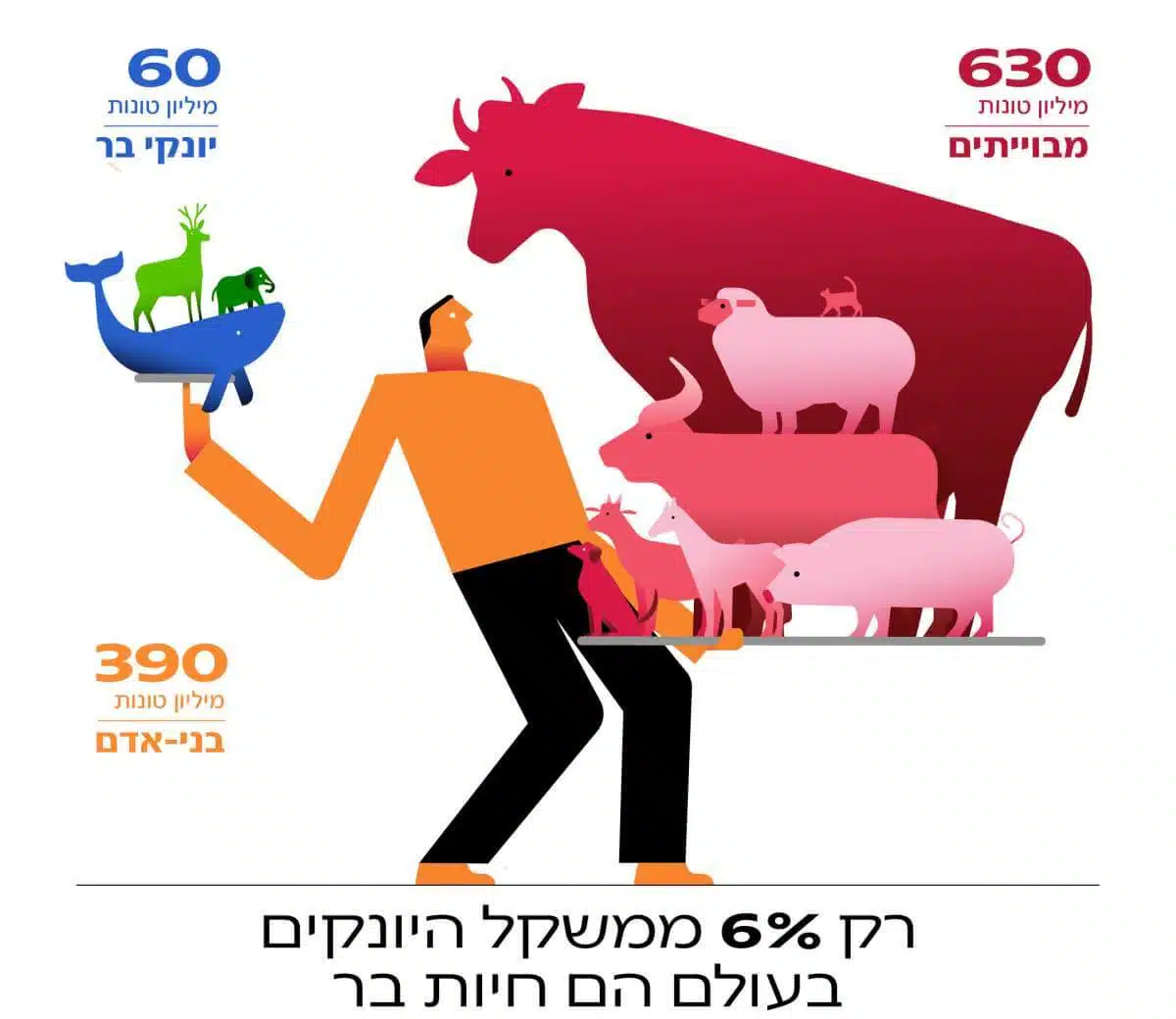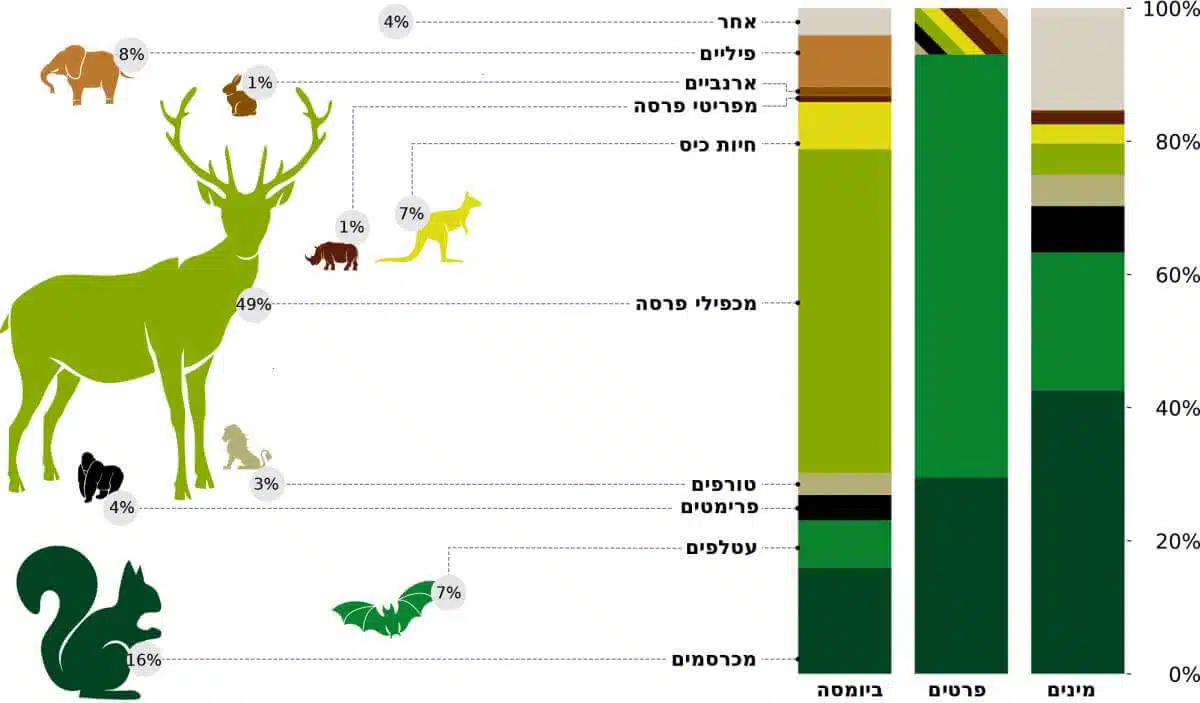The biomass of cows, pigs, sheep and other farm animals is currently 30 times greater than that of all elephants, elk and other wild land mammals combined

In man's imagination, nature is infinite: the great plains, the mountains, the deserts, the rainforests, the depths of the oceans. But in recent decades it has become increasingly clear that this is indeed a wonderful world, as the iconic BBC nature series is named, but also a world in which nature is disappearing. Now, a new study by Weizmann Institute of Science scientists adds a new angle to the grim picture: according to the findings published today in the scientific journal PNAS, the total biomass of elephants, moose, whales and other wild mammals at sea and on land dwarfs that of cows, pigs, sheep and other domesticated mammals. The research team led by Prof. Ron Milo He calculated and found that the weight of farm animals reaches about 630 million tons - 30 times more than the biomass of terrestrial wild mammals (about 20 million tons) and 15 times that of marine wild mammals (about 40 million tons).
Who weighs more? The biomass of humans, of farm and pet animals, and of wild mammals (Illustration: Itay Reva)
"It's easy for us to imagine that nature is vast and endless and will always be there for us. In practice, the weight of all wild terrestrial mammals remaining in the wild is less than 10% of the weight of humans in the world."
To calculate the biomass of members of our warm-blooded class, the research team collected existing censuses of mammal species in the wild and various estimates regarding the number of individuals of hundreds of mammal species. The collected information was translated by the researchers, led by research students Lior Greenspon and Eyal Krieger, into biomass. In this way, the researchers put together about 50% of the global biomass puzzle, and deduced the rest - mammal species for which the data was incomplete or missing - using a machine learning-based computational model that weighs several variables, including the weight of the individual, the area of distribution, the diet and the zoological association. The analysis also revealed that the human influence is not only limited to increasing the biomass of farm animals, but also redefines life in the natural spaces: many of the ones that stand at the top of the biomass list of wild mammals were largely there due to human involvement, for example certain species of elk and wild boar that are now seen as a nuisance in different parts of the world.
The new estimates provided by the research regarding the relationship between different populations of mammals may help monitor populations of wild mammals around the world, as well as help assess the risk of diseases that spread from animals to humans - a dynamic that, according to many epidemiologists, will continue to be a source of epidemics.
3 kilograms per person
Wild mammals are a source of inspiration for humanity, and are often used as symbols to encourage nature conservation efforts. In order to understand in a deeper way the influence of man on nature, the change in the biomass of mammals over the last hundred years is currently being analyzed in Prof. Milo's laboratory. "For me, it's interesting, for example, to understand when the weight of domesticated mammals crossed the weight of wild mammals," says Grinsfon. "These numbers can help in setting nature conservation goals and give another perspective on long-term global processes."

"The more we are exposed to nature in all its glory - whether through videos, museums or tourism to nature reserves around the world - it is easy for us to imagine that nature is vast and endless and will always be there for us. In practice, the weight of all wild terrestrial mammals remaining in the wild is less than 10% of the weight of humans in the world - only about 3 kilograms per person on average," Prof. Milo concludes. "In other words, our research quantitatively shows the magnitude of our impact, and how our decisions and choices in the coming years will determine what will remain of nature for future generations."


Mammals in numbers:
- About 390 million tons - the total weight (biomass) of humans.
- About 630 million tons - the biomass of farm animals. The highest biomass in this category and in general are cows with about 420 million tons.
- 20 million tons - the biomass of land wild mammals.
- Out of the total weight of mammals in the world, terrestrial wild mammals make up about 2% and marine wild mammals - about 4%.
- The white-tailed deer, known from the Disney film Bambi, has the largest biomass among wild terrestrial mammals. In the second and third places: the wild boar and the African elephant.
- About 10 species of mammals are responsible for about 40% of the biomass of terrestrial wild mammals.
- The biomass of pigs alone is almost double that of all wild terrestrial mammals.
- The biomass of domesticated dogs is similar and even exceeds that of all wild terrestrial mammals combined.
- About 40 million tons - the biomass of wild marine mammals.
- The right whale has the largest biomass among wild marine mammals. Whales also hold the second and third places: humpback and fin whale, respectively.
- Biomass studies present a different perspective on the world. For example, bats, with their 1,200 different species, make up about a fifth of the total number of land wild mammal species and about two-thirds of the total number of these mammals, but make up only a tenth of the biomass.
More of the topic in Hayadan:
